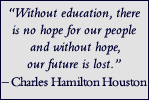|
• Issue No. 53 (Autumn 2006)
Vital Signs: Statistics That Measure the State of Racial Inequality
In each issue, The Journal of Blacks in Higher Education collects statistics bearing on the relative status of blacks and whites, some of which are interesting but not particularly important whereas others are highly relevant and critical to the measurement of racial progress.
(Note: Boldface type suggests items of positive or important change.)
• Actual total black enrollments in higher education in 2004: 2,165,000
• Estimated total enrollments of blacks in higher education in 2015: 2,755,000
(U.S. Department of Education)
• The average number of miles a white student traveled from home to attend college in 2004: 130
• The average number of miles an African-American student traveled from home to attend college in 2004: 119
(U.S. Department of Education)
• Percentage of all African-American workers in 1983 who were members of a labor union: 31.7%
• Percentage of all African-American workers in 2005 who were members of a labor union: 15.1%
(Center for Economic and Policy Research)
• Percentage of nine-month-old white children in 2002 who lived in the same household as their biological father: 88%
• Percentage of nine-month-old African-American children in 2002 who lived in the same household as their biological father: 41%
(U.S. Department of Education)
• Total number of professional degrees in optometry awarded in the United States in 2003: 1,281
• Total number of professional degrees in optometry awarded to blacks in the United States in 2003: 33
(U.S. Department of Education)
• Percentage of all white undergraduate college students in 2004 who lived on campus: 17.2%
• Percentage of all African-American undergraduate college students in 2004 who lived on campus: 12.2%
(U.S. Department of Education)
• Percentage of all white students who applied to medical school in 2006 who were accepted for admission: 49.4%
• Percentage of all African-American students who applied to medical school in 2006 who were accepted for admission: 41.9%
(Association of American Medical Colleges)
• Percentage of all black high school sophomores in 1980 who participated in music-related activities in high school: 37.9%
• Percentage of all black high school sophomores in 2002 who participated in music-related activities in high school: 21.6%
(U.S. Department of Education)
• Percentage of all black high school sophomores in 1980 who said that having lots of money was important to them: 48.4%
• Percentage of all black high school sophomores in 2002 who said that having lots of money was important to them: 60.4%
(U.S. Department of Education)
• Percentage of all black high school sophomores in 1980 who participated in school athletics programs: 57.1%
• Percentage of all black high school sophomores in 2002 who participated in school athletics programs: 48.8%
(U.S. Department of Education)
• Number of reported hate crimes in the United States in 2005: 7,163
• Percentage of all reported hate crimes that were motivated by race: 54.7%
(Federal Bureau of Investigation)
• Percentage of all known perpetrators of hate crimes in 2005 who were white: 60.5%
• Percentage of all known perpetrators of hate crimes in 2005 who were black: 19.9%
(Federal Bureau of Investigation)
• Percentage of all white high school sophomores in 2002 who said it is important to correct social and economic inequality: 14.8%
• Percentage of all black high school sophomores in 2002 who said it is important to correct social and economic inequality: 28.8%
(U.S. Department of Education)
• Percentage of all African Americans over the age of 17 in 1991 who had taken some kind of adult education course over the previous 12 months: 25.9%
• Percentage of all African Americans over the age of 17 in 2001 who had taken some kind of adult education course over the previous 12 months: 43.3%
• Percentage of all whites over the age of 65 in 2005 who held a four-year college degree: 20.2%
• Percentage of all African Americans over the age of 65 in 2005 who held a four-year college degree: 11.0%
(U.S. Bureau of the Census)
• Percentage of all white adults in the U.S. over the age of 25 in 2005 who held a two-year community college degree: 9.2%
• Percentage of all African-American adults in the U.S. over the age of 25 in 2005 who held a two-year community college degree: 7.9%
(U.S. Bureau of the Census)
• Percentage of all white adults in the U.S. over the age of 25 in 2005 who had completed high school: 90.1%
• Percentage of all African-American adults in the U.S. over the age of 25 in 2005 who had completed high school: 81.1%
(U.S. Bureau of the Census)
• Number of African-American adults in the United States in 2005 who had no schooling past the sixth grade: 654,000
• Number of African-American adults in the United States in 2005 who had no schooling past the eighth grade: 1,196,000
(U.S. Bureau of the Census)
• Total number of black first-year students who have enrolled at the California Institute to Technology over the past five years: 8
(JBHE annual survey of black freshmen)
• Percentage of all non-Hispanic white people in the United States in 2005 who were not covered by health insurance: 11.3%
• Percentage of all African Americans in the United States in 2005 who were not covered by health insurance: 19.6%
(U.S. Bureau of the Census)
JBHE Past Vital Statistics
• Issue No. 52 – Summer 2006
• Issue No. 51 – Spring 2006
• Issue No. 50 – Winter 2005/2006
• Issue No. 49 – Autumn 2005
|



